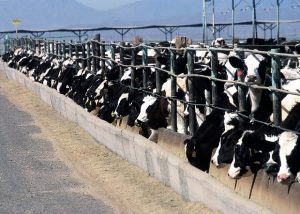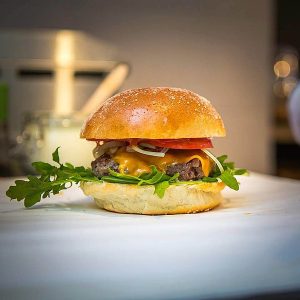2 Beef: Classic Burger
We eat land, water and air – magical, isn’t it?.

From global to local chains, burgers are sold and eaten all around the world. The origin of the classic cheese burger started in the US, and has taken off in all directions – simple to extravagant, cheap to expensive, small (sliders) to gigantic (taking a single bite is a struggle). But a burger is so much more than just the patty, and its colourful fillings and sides.
The patty alone is the cow, but it is also the land, the water, and the air. The land includes the moment, the before and the after – this includes the pasture land…or CAFOs (confined animal feeding operations), the animal feed land (essentially, corn fields) and the factory and supermarket lands that gets cow into ground beef. The water is based on the same assessments – there is more than just consumption, but pollution of water, from excess untreated manure.
The air is a major environmental impact of cows. Agriculture alone accounts of roughly 30% of global greenhouse gases. Cows, along with goats and sheep, are ruminants – mammals that can ferment and break down plant-based food in specialised stomaches. In the process it release methane, commonly referred to as cow “burps.” With so many cows, packed into confined areas, the “burps” and manure production makes a large portion of greenhouse gas emissions creating unpredictable climate in every corner of the globe.

Cows, beef and meat are not very positive. There is little that can be said about why you should eat beef, but like myself, trying to completely cut delicious burgers from my life is a tough one I have not succeeded in (and probably never will). But being vegetarian is not the only option. If everyone cut their meat consumption by half, it is the same as half the people going vegetarian.
Play Your Part:
- Limit your intake of beef (once every two weeks, or as best as you can). Even the founder of Tree Hugger, leading sustainability media outlet is not vegetarian – instead he is a Weekday Vegetarian.
- Choose the sustainably grown ones (think grass-fed, locally sourced, non-CAFO) – talk to the farmers and ranchers
- Switch to alternate burger ingredients – soy, tofu, beans…the list goes on
The standard hamburger is so much more than just a beef patty. Before college, McDonald’s was my definition of burgers. From Shake Shack to nice old-style American diners, I have tried and realised that burgers can be quite a delicious dish, with so much variation – simple to extravagant, spicy to sweet, and small (I like the sliders) to gigantic (a single bite becomes a struggle). But classic is classic: below is a from-scratch recipe for outside-crispy, inside-juicy burger – just the way I like it. Customize with spices, sauces and fillings, and much more to create your unique burger recipe!

The Classic Burger (from Serious Eats)
Yield: 4 burgers
Ingredients:
- 6 oz beef sirloin, trimmed of gristle, and cut into 1-inch cubes
- 5 oz beef brisket, trimmed of gristle, and cut into 1-inch cubes
- 12 oz oxtail, fat and meat carefully removed from bone and trimmed of silverskin (about 5 ounces of combined fat and meat)
- kosher salt
- freshly ground black pepper
- 1/2 tsp of vegetable oil
- 4 slices of American cheese
- 4 soft white burger buns, lightly toasted
Special Equipment:
- meat grinder or food processor
Directions:
- Place feed shaft, blade and 1/4-inch die of meat grinder into freezer
- Place meat chunks on rimmed baking tray, leaving place between each piece. Place in freezer for roughly 10 minutes, until meat is firm, but not frozen
- Combine meat in large bowl, and toss to combine.
- Grind meat directly on to parchment or foil-lined baking sheet
- Without picking up the meat, divide into four piles on baking sheet, and gently press piles into patties (should be loose and have ragged-edges)
- Season generously with salt and pepper. Repeat on both sides, using spatula to flip (push back together if they fall apart)
- Heat vegetable oil in pan until smoking. (Note: there will be lots of smoke from this point onwards – open windows, deactivate fire alarms and be ready for your clothes and house to smell burger-y)
- Place patties into pan, and cook without moving until dark crust forms (roughly 2 1/2 minutes)
- Flip patties and top with cheese, for 1-2 more minutes
- Transfer patties to buns
Recipe Notes:
- Procedure outlined above (freezing, don’t lift with hands etc.) is tried and tested by Serious Eats.
- Specific meat grinder and food processor steps also outlined by Serious Eats
- Between each additional patties to pan, discard all but 1 tsp of fat from pan
- Refrigerate meat after Step 3 or 5 (up to one day)
- Freeze already-formed patties (after Step 5) for longer storage
